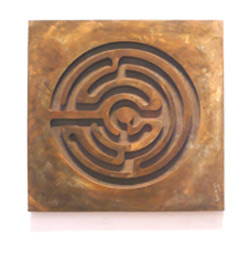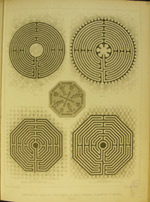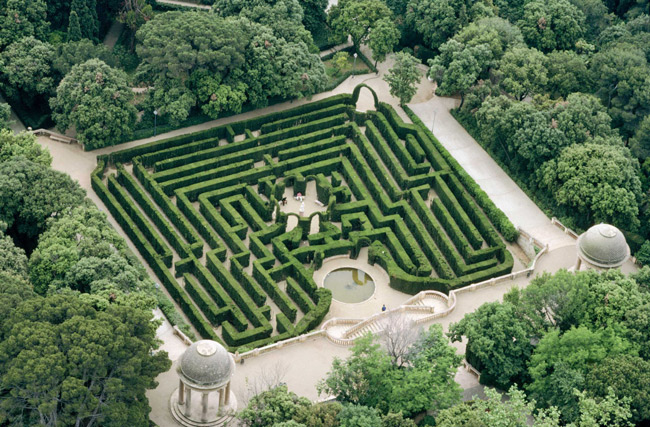The labyrinth as a construction and a symbol is present in many cultural traditions. As explained by Umberto Eco (author of the foreword to the exhibition catalogue), the thousands of years of history of this figure reveal the fascination it has always held for humankind, representing as it does an aspect of the human condition: there are countless situations that are very easy to get into, but more difficult to extract oneself from.
 Ramón de Soto. El laberinto de la memoria / The labyrinth of memory. 2008-2009. 25x25x1 cm. Artist collection
The exhibition makes a clear distinction between single-path labyrinths and mazes, labyrinths with a choice of paths, and reflecting on the relevance of this element and different practices and uses today. It comprises a series of very varied spaces illustrated by works with a variety of different sources, formats, authors and periods, such as archaeological pieces, engravings, photographs, maps, screenings and models, plus specially created audiovisual, animated and interactive pieces. A shade structure has been created in the Pati de les Dones courtyard, with the floor plan of a rectangular labyrinth. The shade structure will be suspended over the arches at the entrance and comprise a system of cables supporting elements that will form the layout of the labyrinth. The shadows cast by this structure on the ground and the walls of the courtyard will form a labyrinth that changes with the sun’s position, which visitors can observe and walk around.
A classic figure: the unicursal labyrinth
In keeping with their aim (the longest route on the smallest surface area), the layout of the space dedicated to unicursal labyrinths is intricate, but there is only one way out. An initial distinction is made between conceptual labyrinths, drawn on stone or paper, which we can follow visually or trace with a finger, and labyrinths that we can physically enter and walk around. This sector includes stone engravings; the Cretan labyrinth represented on coins and Greek pottery; Roman mosaics; labyrinths from Gothic cathedrals; labyrinths as memorials; facsimiles of medieval manuscripts and various books from the 16th to 19th centuries that contain representations of the labyrinth. It also presents the work of contemporary artists such as Robert Morris, Terry Fox and Richard Long, for whom historical labyrinths are a source of inspiration, bringing the representation of the unicursal labyrinth up to the present day. This space ends with a room devoted to the figure of the Minotaur and the relationship between the labyrinth and dance.
 Villard de Honnecourt. S XIII. ed. Impériale, Paris, 1858. Biblioteca de l'Escola Tècnica Superior d'Arquitectura de Barcelona / Library of the Superior Technical School of Architecture of Barcelona
The next section analyzes issues such as the uselessness of Ariadne’s thread in a unicursal labyrinth. It also focuses on Giovanni Fontana (15th c.), the creator of the first intentionally designed mazes that offered the freedom to choose a route at various turning points and the possibility of getting lost after reaching various dead ends. The maze raises the issue of the need for Ariadne’s thread to find one’s way out, as an “external memory” that helps us to retrace our steps to the entrance to the labyrinth. A room is given over to the relation between labyrinth and memory, with an ants’ nest as a central feature that explores the theme from the viewpoint of the natural sciences. Here, the entrance centres on the hedge labyrinths that were planted in numerous aristocratic gardens in Europe between the 16th and 18th centuries. The layout divides into different rooms that develop themes associated with real places (the labyrinth at Versailles) or creators (writers, architects, artists: Borges, Randoll Coate, Patrick Ireland, Michael Ayrton, Friedrich Dürrenmatt, Saul Steinberg, etc.) whose body of work features the theme of the labyrinth. This space also includes a walk-through maze of mirrors and a room with an audiovisual installation that looks at the role of the labyrinth as a space of life in the cinema.
To see more illustrations, click on VERSION FRANCAISE at the top
of this page
| 









